-
Posts
950 -
Joined
-
Last visited
-
Days Won
4
Content Type
Profiles
Forums
Events
Store
Downloads
Gallery
Everything posted by Steve Waszak
-
Next up from the collection I'm assisting my friend in moving are two beautiful iron tsuba, one inlaid with brass in a quite, tasteful design, and the other presenting with a "splashy" display of foliage (maple leaves) in brass and perhaps silver on one side, and then, fascinatingly, with an entirely unanticipated and sophisticated geometric arrangement of linear elements. I have never seen another tsuba with such a starkly different aesthetic expression from one side to the other. The interior elements appear to be brass, while those on the periphery are silver(?). Unfortunately, there is a bit of inlay loss in the outlining of the seppa-dai on one side. There being no hitsuana in either tsuba helps with the strength of the design and expression in both sword guards. The nagamaru tsuba features a triple tomoe motif, with inlaid kiri-mon on the heads of each tomoe. All of the brass is intact on each side, and the iron appears to be very finely forged. A highly appealing tsuba, in my view. Dimensions are 7.9 cm x 7.5 cm x 3.5mm. $475.00 plus shipping. PayPal Friends and Family preferred. The other tsuba has a slight goishi-gata shape, being only about 2.5mm at the rim (approximately 3.5mm at the nakago-ana). This tsuba measures 8.2 cm and is close to perfectly marugata. Two udenuki-ana are present. $475.00 plus shipping. PayPal friends and family preferred.
-
You're quite welcome, Bobby. Happy to help if I can.
-
Hi Bobby, I believe the majority of these copies were 19th-century products, created out of the revivalist spirit that percolated through the Bakumatsu Period. At this time, there was a great nostalgia for the outstanding tsuba of times gone by, especially those of the Momoyama and early-Edo Periods. This is why we see many "homage" works copying the brilliant Nobuiye men of Momoyama, as well as of Yamakichibei, and then also Yagyu. The great father and son Norisuke tsubako of Owari Province -- who were excellent makers of iron tsuba in their own right -- are famous for their efforts to create worthy copies of Yamakichibei and Nobuiye. However, despite their dedication and skills, their works are a far cry from the genuine article, and they were among the very best at making these utsushi. This all goes to show that genius is difficult (read impossible) to replicate convincingly. Real is real, and if one wants that experience -- of seeing and appreciating and "bonding" with that genius, one must have the works of these early masters in hand. Photographs, even the best, simply cannot capture their magic.
-
You're very welcome.
-
Hi Bobby, I'm afraid that would be another "homage" piece. Many details -- from the plate work, shape, sukashi, surface finish, and mei -- are problematic. It can be difficult to see and appreciate the differences between the genuine early Yamakichibei work and that of those who made such "tribute" guards or outright copies. The early Yamakichibei tsuba possess a lively strength that later imitations don't really come close to. It is the same with the later Nobuiye copies or homage works: very far from the real thing.
-
Hi Alex, Well, there could be factors like aesthetics, structural reinforcement, and even just the personal preferences of the person commissioning the tsuba. In the two pieces I mentioned above, these are both ji-sukashi forms with quite a bit of "air" within/among the metal forming the sukashi walls and the rim. Perhaps the very thick rims could be seen as a way to "counter" the relative lack of material substance in the guard?
-
No worries, Marcin! It's great to ask questions. It's how we learn and make progress.
-
I have an Owari sukashi tsuba (Momoyama) with a 7mm rim, and a Kanayama guard (also Momoyama) with an 8mm rim. Not common, but they do exist.
-
100%. This piece is modeled after Meijin-Shodai work. But the mei is wrong in several areas, the sukashi are not formed correctly, the plate is flat and featureless, and it lacks the dynamism and liveliness that is unmistakable in shoshin work. Some years ago, I uploaded a long article I wrote on this group of smiths to the Articles section on NMB. Yamakichibei has been a special area for me in my research on early Owari Province sword guards, so I can say with a very high degree of confidence (100%) that the tsuba here is not shoshin. Also, much of the content of the Varshavsky page linked in Marcin's post here is riddled with errors, so, it is not a reliable source of information on Yamakichibei works. Below are a few examples of genuine Meijin-Shodai Yamakichibei work. Compare. P.S. The other tsuba Marcin posted an image of from the Varshavsky page is also a later copy. Absolutely not shoshin.
-
Hello Marcin, The tsuba here is not a genuine Yamakichibei tsuba. It is a later (likely 19th-century) copy.
-
This is not, of course, one of THE Nobuie greats from the Momoyama age (hence the missing zeroes from the asking price here ), but it certainly is heavily influenced by their designs and workmanship. This is a somewhat extended mokko-gata iron sword guard, featuring a botanical motif, specifically vines and gourds on the ura, and what appears to be trumpet vine on the omote (unless the flowers depicted also belong to the same plant that produces gourds ). The motif is rendered in a sukidashi-bori manner to which has been added a yakite and/or acid treatment finish, making for a very pleasing overall effect. The plate surface around the motif elements is modeled subtly with a gently rendered tsuchime, which also is softened with the yakite/acid finish. The rim of the tsuba is finished with a kikko (tortoise shell pattern). The hitsu-ana are plugged with what I believe is lead. This Nobuie is a little hard to place. There were several later (Edo Period) Nobuie working in areas such as Owari, Echizen, Akasaka, and Kaga, among others. I can't say which one this smith may be, though the forming of the mei appears closest to Echizen or Akasaka Nobuie. Dimensions are 7.4cm x 6.7cm x 5mm. $240.00 plus shipping.
-
I'll PM you, Didier. And I need to clear my message log.
-
Next up is a late-Momoyama to earliest-Edo Period iron Ohno tsuba. This is a classic Ohno work, in that it is compact and powerful, measuring 6.5cm x 6.3cm x 4mm. The plate surface is coarse in texture -- typical for Ohno work -- and features large, bold tekkotsu in quite a prominent manner. This, too, is an element we associate with early Ohno sword guards. The Ohno workers were located in Owari Province, and are thought by many to have had some connection to Kanayama tsuba, as they share some stand-out features. Ohno tsuba tend to be even more compact and direct in asserting the strength of their designs and details. This piece has as its motif the triple tomoe. Despite its size, the tsuba presents with a fairly large nakago-ana, suggesting its intended use on a katana. A really solid tsuba from this school/group and from those times. $300.00 plus shipping.
-
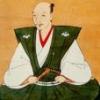
HEAVY shakudo sword guard with silver(?) fukurin
Steve Waszak replied to Steve Waszak's topic in Tsuba
-
The dominant feature of this tsuba is its weight. I do not have a scale handy, but it is among the heaviest tsuba I have ever held. I believe this is owing to its base material, which judging by this weight and the color, is a reasonably high-grade shakudo. A fukurin of silver(?), done in a roped design, and featuring fine, hairline embellishment, offers a wonderful contrast to the shakudo plate. The motif is kebori waves with scattered indaid family crests. I cannot determine with certainty the metal used to form the crests, but it would seem to be copper. The very deep tagane around the nakago-ana is reminiscent of the tagane seen on the sword guards of Hirata Hikozo. Is this guard Higo, then? It isn't really my area of focus and research. Those with more experience in the area of Higo tsuba may have a better read on this piece than I do. Once again, I must emphasize the rather stunning weight of this piece. At 7.8cm x 6mm, the sheer amount of metal here is impressive. This guard is far from my own personal area of focus (Owari Province tsubako), but I find it very appealing. $675.00, plus shipping.
-
Price drop on the Owari tsuba to $275. This is the one and only price reduction on this tsuba.


.thumb.jpg.ee7c96cd57aec114ae2cbb241ac33358.jpg)
.thumb.jpg.28d8eda63f0f2c25f7141a7f23f30aa3.jpg)

.thumb.jpg.0955cb7a888dba4f71742267c923b02c.jpg)
.thumb.jpg.7db473f5ba4b88d33469e4adcd3d7da9.jpg)
.thumb.jpg.2dcce4b9d56584b90224e72631756734.jpg)
.thumb.jpg.ae001c0d5f67070e7ed7127ec7f473ed.jpg)
.thumb.jpg.8acf7fc361238f0ace69cec1984a5bd6.jpg)
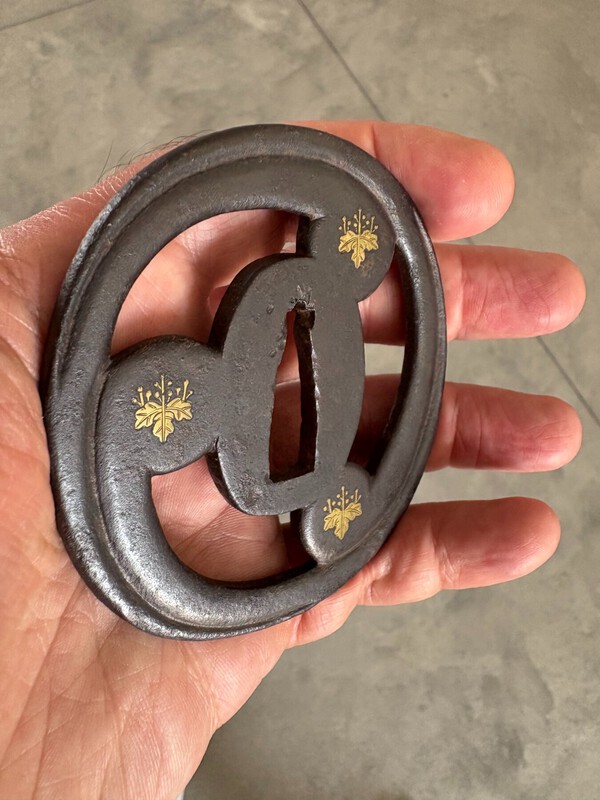
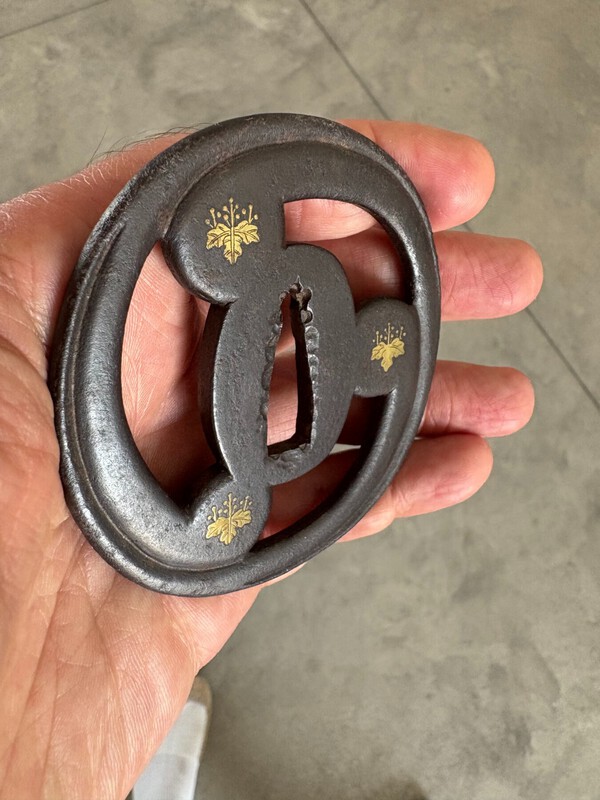
.thumb.jpg.b7e0830f83ed9ae3bb46e9f371068af0.jpg)
.thumb.jpg.f03bbbd4c3fcaba25cab3bb30a35cfc0.jpg)


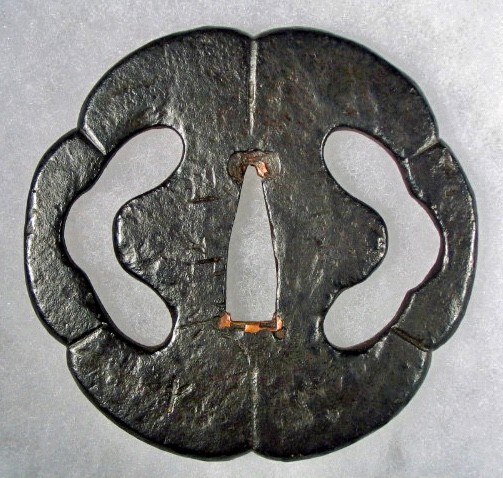


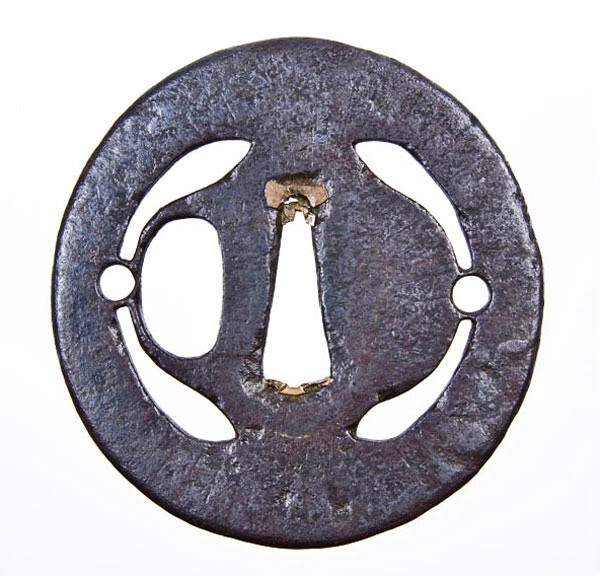
.thumb.jpg.3370cf23b1bc42144397ce5e340f7d9f.jpg)
.thumb.jpg.4516314f92e921525e2147040a51dc62.jpg)
.thumb.jpg.50aa6ea9376075d337584af673119530.jpg)
.thumb.jpg.8eabab1c009b0384392dfd9aa44a6efc.jpg)
.thumb.jpg.811f574ea6e9e9e74cddb28b0a2bae16.jpg)
.thumb.jpg.7f4d0aabb784adeec5879a30e31335a7.jpg)
.thumb.jpg.9e2286fdbd4ed8c1fe20bbed9f4ffd3d.jpg)
.thumb.jpg.89c72ac8bbb134bb9c20279eccc79c63.jpg)
.thumb.jpg.a0a4df2ed89990cc2bc88fc6e4b5946d.jpg)
.thumb.jpg.bba7cc980e0f635cc8c17678519257e0.jpg)
.thumb.jpg.a606f255e99418ebc3b59d5233d225cc.jpg)
.thumb.jpg.27a6c8c1d3ac8451f1131cb31f230812.jpg)
.thumb.jpg.3d3b82492a073ea548e7dd7ea4cf0eb1.jpg)
.thumb.jpg.601f62185181ad277602ab80a8c65204.jpg)
.thumb.jpg.5e1eacbee52724d2697e6bb8c2440347.jpg)
.thumb.jpg.4fc7784d95a0911833d40b89dc53de84.jpg)
.thumb.jpg.0e46d94b6ee39e1c7bd9e103c346ef1e.jpg)
.thumb.jpg.557ae1439f8c839d5efaf2e39988a3a3.jpg)
.thumb.jpg.93185774ac0a7221bfe38b50d742307f.jpg)
.thumb.jpg.4798285c255c11ef54375ddb75ae8e6f.jpg)
.thumb.jpg.894d12aa45ac526ede7d220eaa59b39f.jpg)